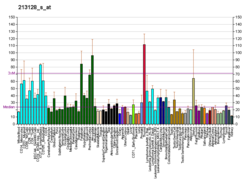Ubiquitin-protein ligase E3A (UBE3A) also known as E6AP ubiquitin-protein ligase (E6AP) is an enzyme that in humans is encoded by the UBE3A gene. This enzyme is involved in targeting proteins for degradation within cells.
Protein degradation is a normal process that removes damaged or unnecessary proteins and helps maintain the normal functions of cells. Ubiquitin protein ligase E3A attaches a small marker protein called ubiquitin to proteins that should be degraded. Cellular structures called proteasomes recognize and digest proteins tagged with ubiquitin.

Both copies of the UBE3A gene are active in most of the body's tissues. In most neurons, however, only the copy inherited from a person's mother (the maternal copy) is normally active; this is known as paternal imprinting. Recent evidence shows that at least some glial cells and neurons may exhibit biallelic expression of UBE3A.[5][6] Further work is thus needed to delineate a complete map of UBE3A imprinting in humans and model organisms such as mice. Silencing of Ube3a on the paternal allele is thought to occur through the Ube3a-ATS part of a lincRNA called "LNCAT"[7] (Large Non-Coding Antisense Transcript).
The UBE3A gene is located on the long (q) arm of chromosome 15 between positions 11 and 13, from base pair 23,133,488 to base pair 23,235,220.
- ^ a b c GRCh38: Ensembl release 89: ENSG00000114062 – Ensembl, May 2017
- ^ a b c GRCm38: Ensembl release 89: ENSMUSG00000025326 – Ensembl, May 2017
- ^ "Human PubMed Reference:". National Center for Biotechnology Information, U.S. National Library of Medicine.
- ^ "Mouse PubMed Reference:". National Center for Biotechnology Information, U.S. National Library of Medicine.
- ^ Jones KA, Han JE, DeBruyne JP, Philpot BD (June 2016). "Persistent neuronal Ube3a expression in the suprachiasmatic nucleus of Angelman syndrome model mice". Scientific Reports. 6 (1): 28238. Bibcode:2016NatSR...628238J. doi:10.1038/srep28238. PMC 4910164. PMID 27306933.
- ^ Grier MD, Carson RP, Lagrange AH (2015-04-20). "Toward a Broader View of Ube3a in a Mouse Model of Angelman Syndrome: Expression in Brain, Spinal Cord, Sciatic Nerve and Glial Cells". PLOS ONE. 10 (4): e0124649. Bibcode:2015PLoSO..1024649G. doi:10.1371/journal.pone.0124649. PMC 4403805. PMID 25894543.
- ^ Runte M, Hüttenhofer A, Gross S, Kiefmann M, Horsthemke B, Buiting K (November 2001). "The IC-SNURF-SNRPN transcript serves as a host for multiple small nucleolar RNA species and as an antisense RNA for UBE3A". Human Molecular Genetics. 10 (23): 2687–700. doi:10.1093/hmg/10.23.2687. PMID 11726556.







